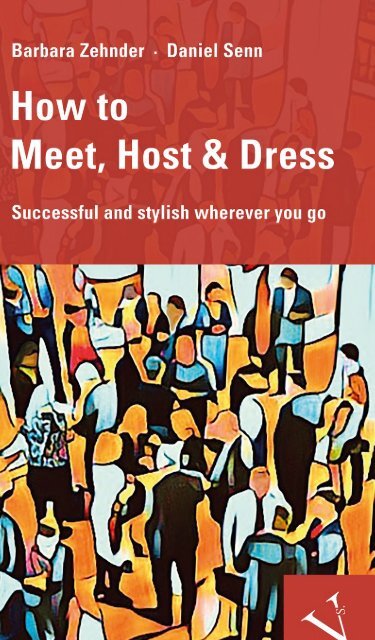Leseprobe: Zehnder/Senn: How to Meet, Host & Dress
Erfolgreiche ePaper selbst erstellen
Machen Sie aus Ihren PDF Publikationen ein blätterbares Flipbook mit unserer einzigartigen Google optimierten e-Paper Software.
This book was originally published in German:<br />
Barbara <strong>Zehnder</strong>/Daniel <strong>Senn</strong>: <strong>Meet</strong>ing, Dining, <strong>Dress</strong> Codes. Erfolgreich<br />
und stilsicher auf jedem Parkett. Versus Verlag Zürich, 2. Auflage 2020,<br />
ISBN 978-3-03909-293-2<br />
Translation: Danielle Adams-Hausheer and John Christian, ZHAW<br />
School of Management and Law, Translation and Editing Service (TES),<br />
ZHAW Zurich University of Applied Sciences, Winterthur<br />
COPYRIGHT – This publication including all its parts are protected by copyright. No section<br />
may be used commercially without the express consent of the publisher. This applies in<br />
particular <strong>to</strong> reproductions, translations, microfilming, and the s<strong>to</strong>rage and processing in<br />
digital systems.<br />
FDFA DISCLAIMER – The authors of this book express themselves in their personal<br />
capacity. While the Swiss Federal Department of Foreign Affairs (FDFA) has given consent<br />
for the publication of this book, the content is not <strong>to</strong> be unders<strong>to</strong>od as an official position of<br />
Switzerland or the FDFA. This book is not an FDFA publication.<br />
***<br />
GENERAL DISCLAIMER – International Courtesy Competence Ltd (hereafter referred <strong>to</strong><br />
as “ICC”) provides the information and source listings in this publication for the reader’s<br />
convenience only. The inclusion of any publication, organisation, or person does not imply<br />
endorsement, sponsorship, or recommendation by ICC. ICC makes no representations or<br />
warranties regarding the competence, suitability, safety, or reliability of any organisation or<br />
person listed. The reader assumes all risks and responsibilities when contacting any<br />
organisation or person mentioned in this publication. ICC does not endorse any third-party<br />
websites that may be mentioned or linked in this publication.<br />
LINKS & QR CODES DISCLAIMER – For the reader’s convenience, ICC provides links<br />
and QR codes <strong>to</strong> third-party websites. These links and QR codes do not imply endorsement,<br />
sponsorship, or recommendation by ICC of the third-party website or its content. ICC does<br />
not moni<strong>to</strong>r or control third-party websites and assumes no responsibility for their content.<br />
Accessing a linked third-party website or QR code is at the reader’s own risk, and ICC will<br />
not be liable for any loss or damage that may arise from such access.<br />
ACCURACY DISCLAIMER – This disclaimer specifically addresses the accuracy of the<br />
information contained in this publication. Please note that while ICC has made every effort<br />
<strong>to</strong> ensure the accuracy of the information provided, it cannot guarantee its completeness or<br />
reliability. The information contained in this book is for general information purposes only<br />
and should not be relied upon as professional advice. ICC makes no representations or<br />
warranties, express or implied, as <strong>to</strong> the accuracy, reliability, or completeness of the<br />
information contained in this publication and assumes no responsibility for any errors or<br />
omissions.<br />
© Pho<strong>to</strong>s with the authors<br />
Pho<strong>to</strong>graphers: Vratko Barcik, Livia Eichenberger, Christian Novak<br />
(Pho<strong>to</strong> credits see page 215)<br />
Cover image: Anna-Sofia Schoenenberger<br />
© 2024 Versus Verlag AG, Zurich<br />
Further information on books available from Versus Verlag can be found<br />
at: www.versus.ch<br />
Layout and production: Versus Verlag · Zurich<br />
ISBN 978-3-03909-393-9
Content5<br />
Content<br />
Foreword . ............................................................. 7<br />
Introduction ........................................................... 9<br />
HOW TO MEET<br />
1 Etiquette ........................................................... 13<br />
1.1 Greeting others ................................................ 13<br />
1.2 Forms of address ............................................... 22<br />
1.3 First name or last name: Which name <strong>to</strong> use ....................... 31<br />
1.4 Introductions . . . . . . . . . . . . . . . . . . . . . . . . . . . . . . . . . . . . . . . . . . . . . . . . . . 32<br />
1.5 Business cards ................................................ 34<br />
1.6 Phone conversations and mobile phone use ....................... 35<br />
1.7 Door etiquette and escorting guests and visi<strong>to</strong>rs ................... 37<br />
1.8 Seating guests of honour ....................................... 39<br />
1.9 <strong>How</strong> <strong>to</strong> respond <strong>to</strong> poor manners ................................ 42<br />
2 Remote Work and Digital Etiquette ................................... 45<br />
2.1 Remote working – the new normal ............................... 45<br />
2.2 Digital etiquette ................................................ 46<br />
3 Conversation and Small Talk ......................................... 48<br />
HOW TO HOST<br />
. 4 You Are a Guest .................................................... 55<br />
4.1 Written invitations and the small print ............................ 55<br />
4.2 Presents for hosts .............................................. 58<br />
4.3 Saying farewell and thanking the host ............................ 60<br />
4.4 Tipping ........................................................ 61<br />
5 Table Manners ...................................................... 64<br />
5.1 Health issues and special diets .................................. 65<br />
5.2 Posture when eating ........................................... 66<br />
5.3 Cutlery, glasses, and napkins .................................... 67<br />
5.4 Eating and drinking ............................................. 69<br />
6 Speeches and Toasts ................................................ 73<br />
6.1 Who speaks when? ............................................ 73<br />
6.2 In what order are guests addressed? ............................. 74<br />
6.3 What should I say? ............................................. 75<br />
6.4 <strong>How</strong> should I look? ............................................. 76<br />
7 You as <strong>Host</strong> or Organiser ............................................. 77<br />
7.1 Planning, organising, and hosting an event ........................ 77<br />
7.2 Event formats .................................................. 83<br />
7.3 Menu and beverage selection ................................... 88
7.4 Sustainable events ............................................. 98<br />
7.5 Invitations .................................................... 100<br />
7.6 Seating arrangements ......................................... 103<br />
7.7 Table culture ................................................. 109<br />
7.8 Your role as the host ........................................... 119<br />
7.9 Pitfalls and mishaps – what <strong>to</strong> look out for ....................... 122<br />
8 Professional Tips From Cooks and Caterers ........................... 123<br />
8.1 Information in recipes ......................................... 123<br />
8.2 Cooking and baking ingredients ................................. 125<br />
8.3 Kitchen knives ................................................ 127<br />
8.4 Food hygiene and hazard analysis ............................... 128<br />
9 Wine, Beer, Spirits, and Low-/Non-Alcoholic Drinks ................... 131<br />
9.1 Wine ........................................................ 131<br />
9.2 Beer ......................................................... 144<br />
9.3 Spirits ....................................................... 146<br />
9.4 NOLO beverages .............................................. 151<br />
9.5 Vegetarian and vegan alcoholic beverages ....................... 153<br />
HOW TO DRESS<br />
10 Event <strong>Dress</strong> Codes – From Casual <strong>to</strong> White Tie . ........................ 157<br />
11 <strong>Dress</strong> Codes in Business . ........................................... 171<br />
12 The Language of <strong>Dress</strong> .............................................. 177<br />
12.1 First impressions – instantaneous and decisive ................... 178<br />
12.2 Impression management and the language of dress .............. 181<br />
12.3 Potentially misleading signals .................................. 183<br />
12.4 Delicate issues ............................................... 185<br />
APPENDIX<br />
Checklists ............................................................ 188<br />
Calculation Lists ...................................................... 198<br />
References, Sources, and Recommended Reading ........................ 209<br />
Index ............................................................... 217<br />
A Word from the Authors ................................................ 221<br />
International Courtesy Competence Ltd ................................. 222<br />
The Authors . . . . . . . . . . . . . . . . . . . . . . . . . . . . . . . . . . . . . . . . . . . . . . . . . . . . . . . . . . 224<br />
6 Content
Foreword7<br />
Foreword<br />
The book “<strong>How</strong> <strong>to</strong> <strong>Meet</strong>, <strong>Host</strong> & <strong>Dress</strong>” is about etiquette. Now why<br />
would etiquette still matter in a society in which “anything goes”?<br />
Because it makes people comfortable and at ease, it shows that they are<br />
valued and respected. It is the sense of “savoir-vivre and savoir-être”.<br />
Etiquette is about behavior, choices, and actions. It is a universal<br />
language that improves interactions in inter-state relations, business,<br />
and private contacts.<br />
The importance of etiquette is particularly evident in an international,<br />
multicultural environment. Far from being old-fashioned, etiquette is a<br />
shared code of respect, an attitude, and a lifelong skill one acquires. It<br />
helps people avoid embarrassing situations, particularly in environments<br />
they are not familiar with.<br />
An embarrassing situation for an individual is one thing, an<br />
embarrassing situation for a state quite another. When state<br />
representatives are being received on official visit by another state, it is<br />
essential <strong>to</strong> respect the pro<strong>to</strong>col – a set of rules on how states and their<br />
representatives must behave – but it is as essential that its representatives<br />
show proof of etiquette knowledge as well. In fact, pro<strong>to</strong>col and<br />
etiquette go hand in hand. Even more, etiquette is no less than an<br />
integral part of pro<strong>to</strong>col. The invited state guest and the accompanying<br />
delegation have <strong>to</strong> be treated with due respect and dignity. Only then<br />
can interactions and negotiations be successful, which in turn deepens<br />
and strengthens relations.<br />
<strong>Dress</strong> codes matter, be it in the business world or in the political<br />
sphere. With the increasing importance of social media, everyone has<br />
<strong>to</strong> be much more thoughtful of how he or she dresses and appears. A<br />
picture tells more than a thousand words. The power of your appearance<br />
should not be underestimated. Whether we like it or not, there is always<br />
a message attached <strong>to</strong> the way we dress.<br />
The book of Barbara <strong>Zehnder</strong> and Daniel <strong>Senn</strong> takes up the <strong>to</strong>pic of<br />
dress codes among a variety of other important aspects of etiquette.<br />
The two authors have put their long international experience and rich<br />
knowledge in<strong>to</strong> a concise, practice-oriented volume.
It is a reference book that should not only figure in every diplomat’s<br />
library. Everyone who is interested in successfully managing important<br />
official and formal situations can benefit from the profound knowledge<br />
it contains.<br />
This reading will facilitate your daily life – promised!<br />
Beatrice Schaer<br />
Ambassador, Head of Pro<strong>to</strong>col from 2019 <strong>to</strong> 2023<br />
Swiss Federal Department of Foreign Affairs<br />
For the international success of a company, every new market entry<br />
depends on thorough preparation and a deep understanding of the<br />
culture and local cus<strong>to</strong>ms. Global business is most profitable when<br />
effective business practices go hand in hand with business relationships<br />
founded on mutual trust and respect and when a company invests<br />
equally in both areas.<br />
What is true in the diplomatic world is just as relevant in the<br />
corporate world. With ever-increasing global interdependencies, a<br />
sound understanding of international etiquette and local codes of<br />
conduct has never been more important. In the future, companies will<br />
be measured not only by their balance sheets but also by how they, and<br />
their employees, conduct themselves. Clear, universally recognised<br />
rules of behaviour can provide valuable guidelines. Applied throughout<br />
a company, they ensure a confident presence both in domestic and<br />
international markets and help establish and maintain stable, mutually<br />
beneficial business relationships.<br />
Barbara <strong>Zehnder</strong> and Daniel <strong>Senn</strong>’s book contains an excellent set<br />
of guidelines and offers valuable tips and sound advice for<br />
businesspeople. Their recommendations are easy <strong>to</strong> apply and explain<br />
how <strong>to</strong> deal with business partners, local organizations, and government<br />
representatives all over the world – ensuring that you always present<br />
yourself in the best possible light.<br />
Thomas Först<br />
Head of Export Promotion & Global Network<br />
Member of the Executive Committee<br />
Switzerland Global Enterprise<br />
www.s-ge.com<br />
8 Foreword
Introduction9<br />
Introduction<br />
Feeling confident and making a good impression when invited <strong>to</strong> a<br />
business dinner or hosting your own event is easier if you know the<br />
rules of the game.<br />
This handbook is for anyone working in a national or international<br />
context – business professionals; diplomats and parliamentarians;<br />
representatives of international organisations, development agencies,<br />
and non-governmental organisations; people working in <strong>to</strong>urism and<br />
culture promotion; security operatives; members of commercial and<br />
sports delegations; and many others.<br />
Dependable information and background knowledge, combined<br />
with numerous tips, tricks, and critical insights, will help you <strong>to</strong> stay<br />
relaxed, anticipate the unexpected, and avoid embarrassing mishaps.<br />
Find answers <strong>to</strong> questions such as:<br />
Should I use formal titles in greetings?<br />
<strong>How</strong> do I make small talk?<br />
<strong>How</strong> can I manage the over-talkative guest without offending them?<br />
<strong>How</strong> should I behave at the dining table?<br />
What is required when hosting a formal business event?<br />
What pitfalls and mishaps should I be prepared for?<br />
<strong>How</strong> do I respond <strong>to</strong> a <strong>to</strong>ast?<br />
Am I overdressed or underdressed for a particular event?<br />
Am I sending unintended signals through my choice of clothes?<br />
The recommendations in this book will help you in the international<br />
arena. <strong>How</strong>ever, they need <strong>to</strong> be applied with a degree of flexibility.<br />
Politeness or formality is not unders<strong>to</strong>od in the same way everywhere.<br />
Direct eye contact, for example, is perceived as disrespectful in Asian<br />
countries. In Western countries, however, it is usually perceived as an<br />
expression of self-confidence and a sign of trustworthiness. Enquire<br />
about local cus<strong>to</strong>ms whenever you are a guest in another country;<br />
showing interest will be seen as a mark of respect <strong>to</strong> your hosts.<br />
Knowledge of international etiquette and openness <strong>to</strong>wards other<br />
cultures are power skills that open many doors.<br />
<strong>Meet</strong>ing & greeting, wining & dining, dress codes & styling: We<br />
have become experts in these areas through our professions and our<br />
activities on the diplomatic stage. Taken <strong>to</strong>gether, we have lived on six<br />
continents in 17 different countries. In 2014, we founded International<br />
Courtesy Competence. Valuable feedback in international workshops
and seminars, as well as on the German-language editions of our book,<br />
inspired us <strong>to</strong> write an English version. Here, we share our expertise,<br />
personal insights, and accumulated experience.<br />
We want <strong>to</strong> thank our partners, Christian Schoenenberger and<br />
Philippe Bärtschi, for their unwavering and unconditional support of<br />
our book project, especially Christian for his meticulous proofreading.<br />
Danielle Adams and John Christian have translated our book, and our<br />
thanks go <strong>to</strong> them. Thank you also <strong>to</strong> Anne Buechi, Judith Henzmann,<br />
and Anja Lanz from Versus Publishing. Livia Eichenberger’s pho<strong>to</strong>s<br />
are artful, as is the cover image by Anna-Sofia Schoenenberger. We are<br />
grateful <strong>to</strong> Beatrice Schaer and Thomas Först, both international<br />
professionals, for their forewords. Without these contributions, this<br />
English-language edition would never have come in<strong>to</strong> being. Thank<br />
you one and all.<br />
Berne and Rome, September 2023 Barbara <strong>Zehnder</strong> and Daniel <strong>Senn</strong><br />
<strong>How</strong> <strong>to</strong> Use This Book<br />
You can read this book as you would a travel guide. Specific information<br />
can be accessed quickly and easily. Individual sections can be read in<br />
isolation and in any order.<br />
If you would like <strong>to</strong> know more, you will find additional information in<br />
the text boxes marked with the following symbols:<br />
His<strong>to</strong>rical background<br />
Further information and details<br />
Around the world<br />
Practical advice<br />
S<strong>to</strong>ries<br />
Metric / US cus<strong>to</strong>mary measurement systems<br />
Throughout this book you will find measurements in both the metric<br />
and the US cus<strong>to</strong>mary measurement systems. For the difference<br />
between the proof system and alcohol by volume (ABV), see page 136.<br />
As a reader of this book, you can access bonus material<br />
on the International Courtesy Competence website.<br />
Read the QR code for more information:<br />
Website: www.courtesycompetence.com<br />
Username: contact@courtesycompetence.com<br />
Password: MeHoDre-ICC3005<br />
10 Introduction
HOW<br />
TO MEET
Whether we are at our first job interview, receiving cus<strong>to</strong>mers, or<br />
travelling abroad on business, we want <strong>to</strong> make a good impression. We<br />
want <strong>to</strong> succeed, and we know that our appearance plays an important<br />
role. <strong>How</strong> do I introduce myself? Do I stand up <strong>to</strong> greet the others or do<br />
I remain seated? <strong>How</strong> do I greet a foreign guest? <strong>How</strong> do I strike up a<br />
conversation with a taciturn cus<strong>to</strong>mer in an eleva<strong>to</strong>r or get down <strong>to</strong><br />
business with someone dominating the conversation at a working<br />
lunch?<br />
In our everyday environment, we do not usually give much thought<br />
<strong>to</strong> how or in what order we greet others. This changes when we are<br />
confronted with an unfamiliar situation, especially in a professional<br />
context.<br />
International business etiquette requires us <strong>to</strong> master various skills,<br />
including the ability <strong>to</strong> correctly greet others, make small talk, introduce<br />
ourselves correctly, give precedence <strong>to</strong> others where needed, handle<br />
business cards, write emails, behave appropriately online, and manage<br />
the dos and don’ts of dealing with cus<strong>to</strong>mers from all over the world.<br />
If you are familiar with these conventions, you will feel more confident.<br />
Knowing how <strong>to</strong> act in any situation is not a guarantee for success, but<br />
it should in no way be underestimated. What we can guarantee is that<br />
with increasing routine, you will gain that ease in dealing with people<br />
that opens a great many doors.<br />
In this chapter, you will find detailed rules of international business<br />
etiquette on meeting and greeting others. The additional notes in the<br />
text boxes are useful if you are interested in background information.<br />
12 HOW TO MEET
1.5 Business cards<br />
Business cards are an essential means of communication. They are<br />
exchanged at the first (professional) meeting, usually at the beginning<br />
of the conversation, sometimes at the conclusion. Offer your business<br />
card <strong>to</strong> the highest-ranking person first. <strong>How</strong>ever, you should not ask a<br />
higher-ranking person for their business card.<br />
The way you handle business cards (carefully – or negligently)<br />
reflects on you. Make sure that …<br />
your business card is clean, unwrinkled, and up-<strong>to</strong>-date;<br />
you do not pull your business card out of your back pocket;<br />
you hand your business card <strong>to</strong> the other person (rather than simply<br />
pushing it across the table);<br />
you hand over the card with the writing facing up, so it is easily<br />
readable by the other person; and<br />
you make eye contact with the other person while doing this.<br />
It is considered rude <strong>to</strong> write on someone’s business card in their<br />
presence. This is only acceptable with your own business card (e. g.,<br />
writing down an additional phone number before handing it over).<br />
It is cus<strong>to</strong>mary at a meeting <strong>to</strong> place the business cards you have<br />
received on the table in front of you.<br />
In China, Korea, and Japan, handing over and receiving a business<br />
card is a small but important ceremony (Fox, 2008). The business card<br />
is presented and accepted with both hands, accompanied by a small<br />
bow. The business card is <strong>to</strong>uched at the <strong>to</strong>p corners without obscuring<br />
the name and company logo. Take time <strong>to</strong> read the business card.<br />
Putting it away unread would be considered disrespectful. Other<br />
countries, other cus<strong>to</strong>ms: In India in general, and in some Islamic<br />
regions, the business card is handed over or received with the right<br />
hand only since the left hand is considered unclean.<br />
It is advisable <strong>to</strong> have a plentiful supply of business cards with you. In<br />
shopping malls and large hotels, there are s<strong>to</strong>res where business<br />
cards can be printed within 24 hours, preferably in English on one side<br />
and in the local language on the other. Ask a native speaker with<br />
knowledge of your business <strong>to</strong> check the local language wording.<br />
34 HOW TO MEET
1.5.1 Electronic business cards<br />
These days, you can quickly and easily exchange contact information<br />
using your mobile phone. Taking a picture of a business card is also an<br />
efficient way. Contact lists or cus<strong>to</strong>mer files can subsequently be<br />
synchronised using an app. In fact, there are numerous inexpensive<br />
apps with which <strong>to</strong> design, create, s<strong>to</strong>re, and send digital business cards<br />
<strong>to</strong> other mobile devices and s<strong>to</strong>re and annotate third-party business<br />
cards. Working with a digital business card folder is easy and<br />
convenient.<br />
Instead of exchanging paper or physical business cards, it is<br />
becoming increasingly common <strong>to</strong> use different types of electronic<br />
business cards for exchanging contact data. So make sure your<br />
information is always up <strong>to</strong> date. Despite all the new<br />
possibilities digital technology offers, printed business<br />
cards are still very popular among most age groups.<br />
For examples of business card apps<br />
read the QR code.<br />
Comply with local and international data protection regulations and<br />
laws. Business cards collected at cocktail receptions, trade shows,<br />
and other events are subject <strong>to</strong> the data protection provisions<br />
applicable.<br />
1.6 Phone conversations and mobile phone use<br />
Make it a policy not <strong>to</strong> use your mobile phone during a visit or while<br />
you are in a meeting. You should give your undivided attention <strong>to</strong> the<br />
people present. Making a phone call or reading your emails implies<br />
that these activities are more important <strong>to</strong> you than the people present.<br />
Even simply placing your mobile phone in front of you on the table<br />
suggests a willingness <strong>to</strong> interrupt the conversation <strong>to</strong> deal with<br />
something “more important”. If you are expecting an urgent call, let<br />
those you are with know beforehand. When a phone call comes in,<br />
excuse yourself and move away <strong>to</strong> take the call. If you are called on a<br />
landline phone during a meeting, apologise for the interruption, answer<br />
1 Etiquette<br />
35
HOW<br />
TO HOST<br />
3 Conversation and Small Talk<br />
53
Around the world, an invitation <strong>to</strong> lunch or dinner is an essential part<br />
of maintaining personal, official, and business relationships. Both as a<br />
guest and a host, it is helpful <strong>to</strong> understand international table manners.<br />
When should you begin eating? Should you raise your glass <strong>to</strong> make a<br />
<strong>to</strong>ast? Where does the napkin go if you have <strong>to</strong> leave the table for a<br />
moment?<br />
When inviting guests <strong>to</strong> a meal or a standing reception – in a<br />
restaurant or a private setting – good organisation is the key <strong>to</strong> hosting<br />
a successful event. Invitations, the choice of menu and suitable wines<br />
and other beverages, local and international cus<strong>to</strong>ms, the seating<br />
arrangements, the servers, table speeches, and <strong>to</strong>asts – with foresight,<br />
everything can run like clockwork, and embarrassing mishaps can be<br />
avoided.<br />
“<strong>How</strong> <strong>to</strong> <strong>Host</strong>” begins from the guest’s perspective, but it also<br />
outlines the role of the host and covers the many small details that<br />
ensure a memorable event. Whether you are a hands-on host or delegate<br />
the task <strong>to</strong> others, you will find a wealth of information and professional<br />
advice that has proven invaluable through many years of international<br />
practice.<br />
54 HOW TO HOST
7.7.5 Menu cards<br />
When are menu cards useful?<br />
At set meals.<br />
To clear up any ambiguities.<br />
To indicate a choice (two starter options, fish or meat, etc.).<br />
To provide a brief explanation of the dishes and wines (if any).<br />
To indicate the approximate timeframe of the event.<br />
To warn of any potential allergens.<br />
To advise on the source of ingredients (this may be a legal requirement<br />
in some countries, e. g., the country of origin of the meat).<br />
Where should they be placed?<br />
Under the napkin.<br />
On the place setting.<br />
Above the place setting.<br />
Design tips:<br />
Simple, understandable wording (refrain from lengthy explanations).<br />
Instead of a separate place card (see 7.7.7 “Place cards”, page 118),<br />
the names of guests can also be printed on the outside of the menu<br />
card or written by hand.<br />
120 g/m 2 (80 lb) card s<strong>to</strong>ck, print in landscape format; then fold in<br />
half.<br />
7.7.6 Table plan<br />
If you are organizing an event where you want or need <strong>to</strong> keep a<br />
particular seating arrangement, it is advisable <strong>to</strong> create a table plan (see<br />
7.6 “Seating arrangements”, page 103). It is a good idea <strong>to</strong> display a<br />
table plan next <strong>to</strong> the dining room entrance, especially for events with<br />
several tables (16 people or more). This prevents guests from searching<br />
for their seats for a long time or standing in line when asked <strong>to</strong> come <strong>to</strong><br />
the table. In addition, the table plan is the reference for laying out the<br />
place cards.<br />
For larger events, in addition <strong>to</strong> the table plan, it is helpful <strong>to</strong> have an<br />
alphabetical guest list indicating at which table each guest is seated.<br />
For example, such a list can be displayed with the table plan or near the<br />
cloakroom.<br />
7 You as <strong>Host</strong> or Organiser<br />
117
Consider making the table plan available digitally.<br />
Do not number tables (“Table 1”, “Table 2”, etc.) as this creates<br />
an impression of hierarchy. Instead, choose the names of cities,<br />
mountains, or something similar for tables.<br />
7.7.7 Place cards<br />
Where should these go? Place the legibly written place cards on the<br />
table above the dessert cutlery. The place card shows the guest’s title,<br />
first name, and last name. If the table plan (see 7.7.6 “Table plan”,<br />
page 117) already mentions a title, this need not appear again on the<br />
place card.<br />
Label place cards on both sides so those opposite can also read the<br />
name.<br />
7.7.8 Service pro<strong>to</strong>col<br />
There are several ways in which a guest can be served. The serving<br />
methods listed below are most commonly used in restaurants and at<br />
events.<br />
From the right: set (e. g., place an extra spoon on the table), insert<br />
(place a plate in front of the guest), and remove (clear dishes, salt<br />
and pepper, etc., that are no longer needed from the table).<br />
From the left: offer (food platters from which guests will serve<br />
themselves) and present (placing food on<strong>to</strong> guests’ plates). In<br />
addition, everything located <strong>to</strong> the guest’s left (e. g., salad plate,<br />
bread plate, forks) should be introduced or removed from that side.<br />
Clearing the table:<br />
Service staff should never stack dishes on the table. Lef<strong>to</strong>ver food is<br />
not wiped off a plate in front of a guest (and behind the guest only<br />
in an emergency).<br />
To clear a table, dishes etc. are usually removed from the same side<br />
from which the food was served.<br />
118 HOW TO HOST
7.8 Your role as the host<br />
<strong>Host</strong>s have duties from the beginning <strong>to</strong> the very end of the event. If<br />
you are the host, it is your responsibility <strong>to</strong> ensure that guests feel<br />
comfortable and well looked after. This begins when your first guest<br />
arrives and ends when the last guest has departed.<br />
As host, you direct the course of events. Even more important than<br />
tasteful decorations, exquisite food, and fine wines is the atmosphere<br />
you create:<br />
Welcome every guest.<br />
At formal occasions, receive guests <strong>to</strong>gether with your partner<br />
(if applicable). For an event that you are co-hosting (e. g., music<br />
festival direc<strong>to</strong>r and partner, sponsoring company representative<br />
and partner), form a “receiving line” <strong>to</strong> greet the guests, meaning<br />
both hosts stand in line (with their partners, if applicable), <strong>to</strong> receive<br />
guests.<br />
For larger events, have a place ready for any gifts your guests may<br />
bring. If this is a separate room, have a pen ready <strong>to</strong> make a note of<br />
who brought what. This will help you when you thank them later.<br />
Should gifts be opened in the presence of the guests or not?<br />
Apart from cultural differences (ask about these if you are away<br />
from home), there are arguments for and against such a practice.<br />
In a smaller gathering, it pleases the giver if you unwrap their gift<br />
and thank them for it immediately. <strong>How</strong>ever, you may not want <strong>to</strong><br />
embarrass someone who has brought a more modest gift. Similarly,<br />
you may fear an unwelcome gift and prefer not <strong>to</strong> open it in the<br />
presence of other guests. If this is the case, remember it is the<br />
thought that counts, and your gratitude for the gesture can come<br />
from the heart. In the case of an event with many guests, it is not<br />
possible, purely in terms of time, <strong>to</strong> unwrap the gifts immediately.<br />
Instead, say thank you on the following day, especially if someone<br />
has made their gift personal in some way. You can, of course, write<br />
thank-you notes, even for chocolates or wine, but this is not usually<br />
expected.<br />
7 You as <strong>Host</strong> or Organiser<br />
119
In the business context, there is a growing awareness that gifts must<br />
meet compliance guidelines and not exceed a given value. Check with<br />
your company or the institution you represent in this regard. With<br />
international business contacts, it may be difficult or impossible <strong>to</strong><br />
decline an overly generous gift – the person giving the gift would be<br />
offended, the business relationship would be jeopardized, or the giver<br />
would simply insist and not take no for an answer. Disclose such<br />
instances <strong>to</strong> your company (line manager, legal department). If you are<br />
asked for your preferences in advance, point out any compliance<br />
guidelines. If appropriate, suggest they make a charitable donation in<br />
place of a gift.<br />
See also 4.2 “Presents for hosts” on page 58.<br />
Be sure <strong>to</strong> talk <strong>to</strong> each guest at least once during the event, even if<br />
only briefly (see Chapter 3 “Conversation and Small Talk”,<br />
page 48). <strong>How</strong>ever, this is not always possible with a larger<br />
number of guests.<br />
As a host, you will probably know your guests, but they may not<br />
know each other. Your task is <strong>to</strong> introduce them <strong>to</strong> each other with<br />
their title, name, and function (see 1.4 “Introductions”, page 32).<br />
Before you begin the event, reread the guest list and memorise the<br />
full names as if you were learning vocabulary. Your guests will<br />
appreciate your attention <strong>to</strong> detail.<br />
At the table, signal when <strong>to</strong> start drinking and eating (see 5.4 “Eating<br />
and drinking”, page 69), and, at the end of the meal, when guests<br />
should rise from the table.<br />
Be attentive <strong>to</strong> your dinner guests:<br />
8 If someone has been sitting at the table in silence for a long time<br />
because the guests on either side are talking <strong>to</strong> someone else,<br />
draw this person in<strong>to</strong> the conversation, and enquire about their<br />
view on the current <strong>to</strong>pic of discussion.<br />
8 If a guest dominates the conversation with lengthy monologues,<br />
remember that they will also take an occasional bite of food.<br />
Seize this moment <strong>to</strong> introduce a new <strong>to</strong>pic, preferably prompted<br />
by a question addressed directly <strong>to</strong> another guest.<br />
8 Suppose foreign guests complain about the shortcomings of the<br />
host country – sometimes in the presence of compatriots of that<br />
country. If you are the host, change the subject immediately (see<br />
Chapter 3 “Conversation and Small Talk”, page 48).<br />
120 HOW TO HOST
HOW<br />
TO DRESS<br />
9 Wine, Beer, Spirits, and Low-/Non-Alcoholic Drinks<br />
155
Many of us ask ourselves every day, what should I wear? Should I<br />
dress comfortably in functional clothing or choose an outfit that will<br />
make me stand out from the crowd? What style suits me best? Should<br />
I follow a fashion trend? Every season, the fashion industry launches<br />
new styles for every occasion while influencers and style icons in the<br />
entertainment industry tell us the latest fashion “must-haves” and “nogos”.<br />
Even seasoned fashionistas find it difficult <strong>to</strong> keep pace. In<br />
addition, few of us are prepared <strong>to</strong> invest a vast amount of time and<br />
money in our wardrobes. What <strong>to</strong> wear becomes even more difficult<br />
when we are faced with an invitation <strong>to</strong> an event that has a specific<br />
dress code, such as “smart casual”.<br />
<strong>Dress</strong> codes are meant <strong>to</strong> clarify what <strong>to</strong> wear <strong>to</strong> a particular event.<br />
<strong>How</strong>ever, the only time when this is made absolutely clear is at formal<br />
functions, where men are required <strong>to</strong> wear “black tie” (dark suit, white<br />
shirt, and black bow tie), “white tie” (a tuxedo, a tuxedo shirt, and a<br />
white bow tie), or “morning suit” (a morning coat, waistcoat, and<br />
formal trousers). These are described in more detail in Chapter 10<br />
“Event <strong>Dress</strong> Codes – From Casual <strong>to</strong> White Tie”. For all other dress<br />
codes, there is usually room for interpretation.<br />
<strong>Dress</strong> codes also apply in a professional environment. Every industry<br />
has its own, more or less specific rules for what <strong>to</strong> wear. (Chapter 11<br />
“<strong>Dress</strong> Codes in Business”). Some organisations have a written dress<br />
code, although strict enforcement can lead <strong>to</strong> resistance. Many<br />
employees do not like <strong>to</strong> be dictated <strong>to</strong> about what they can or cannot<br />
wear.<br />
<strong>Dress</strong> codes differ according <strong>to</strong> the cultural region, business sec<strong>to</strong>r,<br />
and status of the wearer. They also change over time.<br />
The <strong>How</strong> <strong>to</strong> <strong>Dress</strong> section of this book is intended <strong>to</strong> provide clarity<br />
on matters of dress. It describes specific dress codes for various event<br />
categories <strong>to</strong> eliminate the most common uncertainties. It also lists the<br />
main criteria for dressing appropriately in a professional context,<br />
which will make it easier <strong>to</strong> make the right decisions. The first<br />
impression counts. In fact, according <strong>to</strong> several studies, it only takes<br />
the blink of an eye <strong>to</strong> form an initial impression of another human<br />
being. This should guide you in choosing your outfit.<br />
As a look at his<strong>to</strong>rical dress codes confirms, since time immemorial,<br />
people have been concerned with who may, should, or must wear what<br />
and on which occasion.<br />
156 HOW TO DRESS
Index<br />
A<br />
Accessories ..................... 183<br />
Afternoon tea .................... 56<br />
Alcohol ........................ 125<br />
Allergens ....................... 203<br />
Allergy ......................... 97<br />
Applying for a job . ............... 172<br />
Appropriateness .................. 59<br />
Assigning seats .................. 106<br />
Audio conference ................. 47<br />
B<br />
Baking ingredients ............... 125<br />
Balancing the menu . ............... 88<br />
Beer . ...................... 144 – 146<br />
Beginning the meal ................ 70<br />
Beverage selection ............. 88, 93<br />
Bill . ............................ 80<br />
Booking . ........................ 81<br />
Bottle shapes .................... 141<br />
Bowing ......................... 21<br />
Brandy . ........................ 149<br />
Bread . .......................... 92<br />
Buffet ................... 86, 91, 200<br />
Business card ................. 34 – 35<br />
Business casual .............. 163, 174<br />
C<br />
Carnations ....................... 60<br />
Casual dress code ................ 157<br />
Caterer . ......................... 82<br />
Catering service .................. 80<br />
Ceremonies ...................... 42<br />
Changing the subject . .............. 50<br />
Clearing the table ................ 118<br />
Clearing up ...................... 70<br />
Clothing laws ................... 158<br />
Clothing regulations .............. 157<br />
Cocktail reception ....... 83 – 84, 89, 198<br />
Compliance ...................... 59<br />
Compliments . ................... 186<br />
Confectionery .................... 58<br />
Conference centre ................. 79<br />
Cookbook quantities .............. 123<br />
Cooking ingredients .............. 125<br />
Corporate dress code . ............. 171<br />
Court etiquette . ................... 42<br />
Cup ........................... 124<br />
Cus<strong>to</strong>ms . ........................ 64<br />
Cutlery . ..................... 67, 112<br />
D<br />
Decorations ...................... 91<br />
Delicate issues . .................. 185<br />
Dessert . ......................... 93<br />
Dietary vegan .................... 95<br />
Diets ........................... 65<br />
Digital business card ............... 35<br />
Digital etiquette . ............... 45 – 46<br />
Digital invitation ................. 101<br />
Dominant handshake . .............. 17<br />
Door etiquette .................... 37<br />
<strong>Dress</strong> code . ......... 157, 163 – 170, 174<br />
<strong>Dress</strong> codes in business . ........... 171<br />
<strong>Dress</strong> regulations . ................ 158<br />
Drink suggestions ................ 201<br />
E<br />
Egg alternative ................... 96<br />
Emojis .......................... 46<br />
Ending the conversation ............ 51<br />
Ending the meal .................. 70<br />
Entertaining at home . ............. 192<br />
Escorting a guest . .............. 37, 38<br />
Ethical vegan . .................... 95<br />
Etiquette ..................... 39 – 40<br />
Event dress code . . . . . . . . . 157, 160 – 161<br />
Event format ..................... 78<br />
Event planning ................... 78<br />
Eye contact ................... 17, 20<br />
F<br />
Finger food ............ 83 – 84, 89, 198<br />
First impression . ................. 178<br />
First in, first out (FIFO) ........... 128<br />
First name ....................... 31<br />
Fish/seafood alternative ............ 96<br />
Flexitarian ....................... 94<br />
Flowers ......................... 58<br />
Food delivery service .............. 80<br />
Food hygiene . ................... 128<br />
Food safety ..................... 129<br />
Food waste ...................... 99<br />
Forks .......................... 113<br />
Formal dress code ........ 157, 168 – 169<br />
Form of address . ............... 23, 26<br />
Fortified wine ................... 137<br />
Freegan ......................... 95<br />
Fruitarian . ....................... 95<br />
Index<br />
217
G<br />
Gastronorm (GN) ................. 88<br />
Gender-neutral salutation ........... 23<br />
GIFs . ........................... 46<br />
Gin . ........................... 147<br />
Glasses ................. 67, 113, 114<br />
Good manners .................... 13<br />
Greeting . ........................ 14<br />
Greeting formula . ................. 74<br />
Guest list ........................ 78<br />
Guest of honour . .................. 39<br />
H<br />
Hand-kissing ..................... 18<br />
Handshake . ................ 13, 17, 20<br />
Hazard Analysis and Critical Control<br />
Points (HACCP) .............. 128<br />
Health issues ..................... 65<br />
Hierarchies ...................... 15<br />
High tea . ........................ 56<br />
Holding an event .................. 82<br />
<strong>Host</strong> . ....................... 77, 119<br />
<strong>Host</strong>ing events . ................... 77<br />
Hotel ........................... 79<br />
Hybrid event ..................... 47<br />
I<br />
Impression management ....... 181, 182<br />
Inappropriate <strong>to</strong>pics of conversation . .. 50<br />
Informal dress code . .......... 157, 164<br />
Interpersonal space ................ 19<br />
In<strong>to</strong>lerance . ...................... 97<br />
Introducing other people . ........... 32<br />
Introducing yourself ............... 33<br />
Invitation ................ 55, 100 – 103<br />
K<br />
Keeping the conversation going ...... 49<br />
Kisses .......................... 19<br />
Knives ............... 59, 67, 113, 127<br />
L<br />
Lac<strong>to</strong>-vegetarian .................. 94<br />
Language of dress ................ 177<br />
Last name ....................... 31<br />
Left hand ........................ 18<br />
Legal considerations ............... 82<br />
Liqueurs ....................... 150<br />
M<br />
Making contact ................... 48<br />
Meal sequences ................... 91<br />
Meat substitute ................... 96<br />
Menu ........................... 88<br />
Menu card ...................... 117<br />
Milk . .......................... 125<br />
Milk alternative . .................. 96<br />
Mishaps . ....................... 122<br />
Misleading signals ............... 183<br />
Mobile phone ................. 35 – 36<br />
Modern menu .................... 90<br />
Moist palm ...................... 17<br />
N<br />
Name . .................... 22 – 23, 26<br />
Napkin . ............... 67, 68 – 69, 116<br />
National costume dress code . ....... 170<br />
Networking event ................. 49<br />
NOLO beverages . ............ 151 – 152<br />
No-show ratio .................... 79<br />
O<br />
Online meeting ................... 47<br />
Oral greeting ..................... 24<br />
Order of greeting . .............. 14, 22<br />
Order of precedence ......... 14, 16, 74<br />
Organiser . ....................... 77<br />
Oven .......................... 124<br />
Ovo-lac<strong>to</strong> vegetarian ............... 94<br />
Ovo-vegetarian ................... 94<br />
P<br />
Perfume . ....................... 185<br />
Pesco-vegetarian .................. 94<br />
Phone call ....................... 35<br />
Physical contact .................. 21<br />
Pitfalls ......................... 122<br />
Place card ...................... 118<br />
Place of honour .................. 107<br />
Place setting ................ 109 – 111<br />
Planning events ............ 77 – 78, 188<br />
Plant-based alternatives . ............ 96<br />
Poor manners .................... 42<br />
Posture . ...................... 18, 66<br />
Precedence ................ 14, 16, 74<br />
Present for the host ................ 58<br />
Pro<strong>to</strong>col . ..................... 39 – 40<br />
Punctuality ...................... 57<br />
Q<br />
Quantity calculation ........... 81, 125<br />
Quotation . ................... 81, 190<br />
R<br />
Range of glasses ................. 113<br />
Ranking of guests ............ 104, 107<br />
Ranking of seats ................. 104<br />
Recipes .................... 123 – 124<br />
Religious dietary rules ......... 97, 202<br />
Remote working .................. 45<br />
Reservation . . . . . . . . . . . . . . . . . . . . . 190<br />
Responding <strong>to</strong> an invitation ......... 57<br />
218 APPENDIX
Restaurant .......... 37, 77, 79 – 80, 194<br />
Rituals .......................... 42<br />
Rum . .......................... 150<br />
S<br />
Salt ....................... 125, 126<br />
Save-the-date . ................... 102<br />
Say goodbye ..................... 60<br />
Saying farewell ................... 60<br />
Seating arrangement .............. 103<br />
Seating guests of honour . ........... 39<br />
Seating plan . ............ 104 , 105, 106<br />
Semi-formal dress code . ... 157, 165 – 167<br />
Sequence of speakers .............. 74<br />
Service pro<strong>to</strong>col ................. 118<br />
Serviette ........................ 69<br />
Set menu ..................... 85, 90<br />
Signature ........................ 47<br />
Sit-down meal ............. 85, 90, 199<br />
Small talk .................... 48, 52<br />
Special cutlery . .................. 112<br />
Speech . ...................... 73, 75<br />
Spirits ...................... 59, 146<br />
Spoken greeting .................. 23<br />
Spoon measures ................. 123<br />
Starting the conversation . ........... 48<br />
Status symbols .................. 181<br />
Stereotypes ..................... 179<br />
S<strong>to</strong>ring bottled wine .............. 141<br />
Stresemann ..................... 170<br />
Stroller . ........................ 170<br />
Sulphite ........................ 138<br />
Sustainable Development Goals<br />
(SDGs) . ...................... 98<br />
Sustainable event . ............ 195 – 197<br />
Sweet wine ................. 136, 142<br />
Venue . .................. 79, 189, 194<br />
Vermouth . ...................... 150<br />
Video conference ............. 47, 176<br />
Visual signals ................... 182<br />
Viticulture ...................... 131<br />
Vodka ......................... 148<br />
W<br />
Waste management ................ 99<br />
Whipped cream .................. 125<br />
Whisky ........................ 146<br />
Wine ....................... 59, 131<br />
Wine abnormalities ............... 140<br />
Wine bottles .................... 205<br />
Wine containers . ................. 140<br />
Wine defects .................... 139<br />
Wine-growing regions . ............ 132<br />
Wine label ...................... 137<br />
Wine sediment . .................. 140<br />
Wine type .................. 142 – 143<br />
Written address ................... 25<br />
Written complimentary close ........ 30<br />
Written invitation ............. 55, 100<br />
Written salutation ................. 29<br />
T<br />
Table manners .................... 64<br />
Table plan .................. 117, 118<br />
Tequila . ........................ 148<br />
Thanking the host ................. 60<br />
Tipping ...................... 61, 63<br />
Title ......................... 22 – 23<br />
Toast ........................ 73 – 75<br />
Types of drinking glasses .......... 114<br />
U<br />
Uniform dress code . .............. 170<br />
V<br />
Vegan food guidelines . ............. 95<br />
Veganism . .................... 94 – 95<br />
Vegan wine ..................... 153<br />
Vegetarian food guidelines .......... 94<br />
Vegetarianism ................. 94, 95<br />
Index<br />
219
A Word from the Authors<br />
In this book, we have compiled advice, tips, and guidelines which, in<br />
our long-term international careers, have proven their validity. We<br />
sincerely hope they will be useful <strong>to</strong> you, as well.<br />
You might think that moving and communicating in style in the<br />
international arena will be challenging, and that remaining cool, calm,<br />
and collected at all times will be impossible. This is not the case. Most<br />
of our tips and rules are easy <strong>to</strong> apply. They will help you <strong>to</strong> be more<br />
aware of the expectations of those around you, avoid embarrassing<br />
situations, and prevent misunderstandings. If something goes wrong –<br />
and that can happen – take it seriously but remember that even a<br />
seasoned professional can make a mistake. In such moments, offer an<br />
honest apology or make a humorous remark at your own expense <strong>to</strong><br />
lighten the mood. Remember the saying, “The show must go on.” In<br />
other words, keep calm and carry on.<br />
The following guideline will serve you well: Treat everyone with<br />
courtesy, respect, and appreciation; use your common sense; and ask<br />
questions whenever you are unsure – especially in an international<br />
context.<br />
We wish you every success in all your international ventures.<br />
Barbara <strong>Zehnder</strong> and Daniel <strong>Senn</strong><br />
PS: We are always interested <strong>to</strong> read about your experiences. To reach<br />
us, please send an email <strong>to</strong> contact@courtesycompetence.com.<br />
12 A Word from the Authors<br />
221
The Authors<br />
Barbara <strong>Zehnder</strong> has been advising companies<br />
and individuals on image presentation, business<br />
etiquette, and how <strong>to</strong> dress correctly since 2003.<br />
Over 30 years of experience in the diplomatic<br />
arena as an event organiser, networker, host, and<br />
partner of a diplomat underpin the practical<br />
relevance of her input. Barbara is particularly<br />
interested in people and their communication –<br />
while focusing on overcoming intercultural<br />
barriers. She demonstrates how communication bridges can be built<br />
through appreciative attention and openness. Barbara has lived and<br />
worked in Switzerland, Belgium, South Korea, Austria, Ukraine, and<br />
Sweden. She currently lives in Switzerland.<br />
Daniel <strong>Senn</strong> has over 30 years of experience in<br />
international hotel management. As a global<br />
professional and co-travelling partner in the<br />
diplomatic service, he has been organising<br />
gatherings, meetings, and promotional events<br />
worldwide for over 25 years. He practises<br />
professional service and hospitality with his heart<br />
and soul, both on and behind the scenes. Daniel<br />
shares his knowledge and experience – from chef<br />
<strong>to</strong> hotel manager – with generosity and enthusiasm. Daniel has lived<br />
and worked in Switzerland, the United States, Saudi Arabia, the Czech<br />
Republic, Thailand, Australia, Brazil, Nigeria, Spain, and Tunisia. He<br />
currently lives in Italy.<br />
224
















